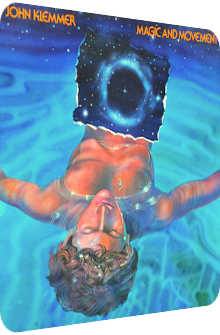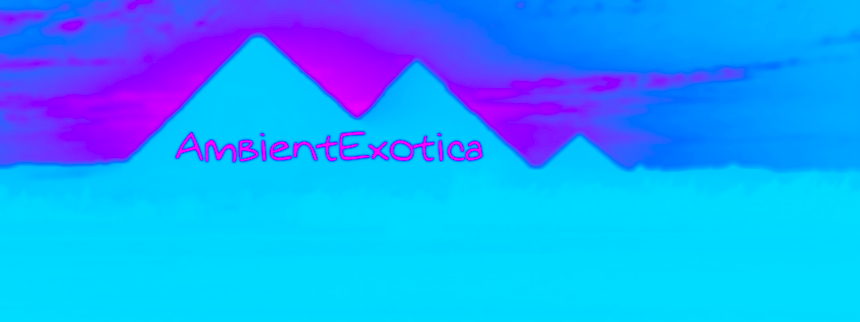
John Klemmer
Magic And Movement
1974
Magic And Movement by tenor saxophonist and composer John Klemmer (born 1946) is the follow-up to his Space-Age and Free Jazz escapade Waterfalls (1972) and released in 1974 on the Impulse! Label. The eight-track album features two live performances of one quintet and one quartet led by Klemmer. The concert on side A is recorded in 1972 at the Ash Grove Club in Los Angeles, whereas side B contains Klemmer’s inaugural performance at the Montreux Jazz Festival in 1973. The band’s show is mercilessly eclectic and electrifying, with complex tone sequences, ever-bubbling flecks and cascading drum constructions swooshing by.
What John Klemmer’s early to mid–70’s works lack in carved out melodies, they deliver in the shapes of textural superstructures and galactic timbres. Vintage Exotica fans can stop reading after this sentence, as it comes down to this: Magic And Movement is a Space-Age album whose propulsion and energy source are based on convoluted Jazz arabesques rather than mauve-colored string washes. Given the affection and taste of Space-Age fans, it might happen that they can stop reading after this sentence as well, but should at least know of the existence of Magic And Movement. As stated above, John Klemmer leads two different bands: side A features bassist Wilton Felder, drummer Eddie Marshall, pianist Mike Nock and guitarist Dean Parks, whereas side B sports bassist Cecil McBee, drummer Alphonse Mouzon and pianist Tom Canning. Even though the album presents two live performances, the audience is only sparsely heard. And best of all, the sound quality is astonishing and makes the hyper-frantic rotor harmonies sound three-dimensional.
It is astonishing how much alike Waterfalls and Magic And Movement really are. Nothing showcases this more efficiently than the latter’s opener. It is the prelude to the triptych Blood Of The Sun. Called the Primary Pulse and being the opener not just of this album but also of the live performance at the The Ash Grove situated in Los Angeles on June 22, 1972, John Klemmer revisits the concept of a purely saxophone-based kick-off. Whereas Prelude I off Waterfalls is unsurprisingly linked to aquatic-cavernous surroundings, Blood Of The Sun, Primary Pulse is fittingly cosmic. Downwards floating tenor saxophone tones, electronically added echoes during post-production and a backdrop of pure darkness are everything there is. Empty and hollow, it evokes the dichotomy of our galaxy’s starlit emptiness.
Blood Of The Sun, Secondary Pulse then becomes a band affair. Under the applause of the audience, Mike Nock’s electric Rhodes piano and the susurrant triangle sparks function as glacial contraventions to John Klemmer’s heavily pulsating stardust saxophone. Bassist Wilton Felder adds electric warmth to the sun’s orbit. Additional jingle-quality synth coils create the impression of being encapsulated in a shelter-maintaining location. Curiously enough, Klemmer’s saxophone is digitally altered and becomes more liquid than on Waterfalls, frothing effervescently to Eddie Marshall’s classic drum kit. Jazzy and eclectic but supercharged with translucent surfaces, Secondary Pulse is chaotic Space-Age par excellence.
Blood Of The Sun, Tertiary Pulse is the final movement of the long-form vision, and since I am a reviewer, the simile of a dying sun which becomes a monstrous red gas balloon that grows ad infinitum is admittedly close at hand, true, but oh so fitting on this piece. However, one should not expect histrionic bass quakes or a sizzling drum mayhem; the effect is more subtle and not at all audible in the infancy stages of that Tertiary Pulse. John Klemmer’s saxophone is mute for the overwhelming majority of this piece of eight minutes which presents a funky interplay between Mike Nock’s electric piano crystals that are silkened and ultra-soft, Eddie Marshall’s easygoing but iridescent hi-hat helixes and Dean Parks’ orange-hued Funk guitar injections. Added samples of a moaning woman in various pitches are not as audacious or de trop as they appear in written form. Once John Klemmer is reintroduced in the last two minutes, his sax is bursting at the seams, spiraling and whirling like a maelstrom, embodying the climactic state in tandem with Eddie Marshall’s increasingly staggering drums. But again, the finale does not feel forced and is by no means cinematic.
As the attending crowd cheers and claps, the quintet presents the final tune of side A and presumably that evening at the Ash Grove: How Cum Ya Gotta Rip Off Your Brothers? is a dirty, semi-nasty megacity anthem loaded with crunchy guitar galores, staccato drums and a back alley saxophone sleaziness that is astutely sun-dappled, but grounded on Earth this time. Neither exotic nor spacey rather than exclusively funky, the song title is screamed into the audience all the while the interstices and clefts create that stop-and-go motion which is so typical for city-infested Funk goodness. Amicably aggressive, playful and bustling, this tune does fit in neither category at AmbientExotica, but since it is a part of the album, I won’t deny its existence. It is, after all, rather cool and both transports and transmutes the political message of respect and living together not despite but because of cultural diversity.
Side B is reserved for Klemmer’s first enchanted evening at the Montreux Jazz Festival in Switzerland, recorded on July 6, 1973. It launches with Free Love, and the tune itself starts with a short saxophone solo which is then gorgeously alloyed by Tom Canning’s electric piano and Alphonse Mouzon’s coruscating cymbals plus drums. Cecil McBee’s monotonously vesiculating bass runlets ennoble this wondrously spacial free-flow performance further. While Free Love does not contain hummable melodies, the tones are indeed catchy and comprise of strong textures. As Klemmer goes really wild on the sax later on, so does Canning on the electric piano; both unleash cosmic glitters of partial incongruence and cacophony, but the freshness of the heliosphere is, at least to me, breathtaking and fittingly refers back to the album title. After Mouzon’s drum shrapnel, the curtain opens for the second triptych called The Tree Of Forbidden Fruit. That’s an exotic title with a biblical innuendo alright, but clearly rooted (!) in ethereal dimensions.
The Alpha Branch features a saxophone solo of approximately 90 seconds that leads to a protuberant spectacle of king-size drums. Klemmer then adds enormously twirling shawm-like saxophone serpentines to the curiously contrapuntal circumambience of electric piano shards. The short Beta Branch does not even cross the two-minute mark, but interpolates Cecil McBee’s aquatic-ligneous bass wobbles in-between the void of fluxion. The final Gamma Branch really puts McBee into the spotlight, as his carefully cymbal-underlined bass solo of a whopping four minutes reminds the listener of the virtual nothingness around him or her. It is the task of the quintet to fight this nonentity in unison. An electrifying turmoil of all instruments puts an end to Klemmer’s fastest-paced and adamantly kaleidoscopic heart flutter-infested whorl he ever created. A blast during workout!
With a cornucopia of good will, Waterfalls could be wafting in the outermost lithosphere of Exotica. Magic And Movement, in comparison, would orbit around the otherworldly stratosphere and is perhaps a late take on the Space-Age genre. Naturally, Space-Age is a fuzzy and often ridiculed concept, but I deem the feeling and aura of it compatible with the categorization of the album. As a whole, the album is coherent enough, but two tunes disturb the magic field of enchantment John Klemmer and his two bands so skillfully erect and maintain: Blood Of The Sun, Primary Pulse is the expected saxophone solo which is only enjoyable for diehard sax aficionados, for Space-Age and Exotica listeners are used to an overabundance of textures and surfaces, and none of them can be provided by any solo, I’m afraid. The second less enthralling piece is the sleazy-muddy city tour that is How Cum Ya Gotta Rip Off Your Brothers?, a midtempo Funk critter where the tonality of the tenor saxophone may be fitting, but the genre as a whole is undoubtedly wrong for the album.
There is, however, anything wrong with the two three-part clusters Blood Of The Sun and The Tree Of Forbidden Fruit as a whole. Winged whirlwinds, luminescent labyrinths, fast flumes, all these alliterations fit with another one: galactic grandiloquence. Fans of partly electronic Jazz albums will feast on Mike Nock’s and Tom Canning’s electric pianos which are as important a part as John Klemmer’s central tenor saxophone, for they are the shooting stars and incandescent ingredients which ameliorate the already aeriform appearance. Space-Age fans who interpret catchiness as the sum of oscillating melodies and awesome textures should check the album out. It is currently only available on vinyl and not on CD, but 2014 might offer a splendid opportunity when its 40th anniversary is celebrated. Vintage Exotica fans can and should avoid Magic And Movement, as it really is too far off the aural rain forests.
Exotica Review 294: John Klemmer – Magic And Movement (1974). Originally published on Dec. 14, 2013 at AmbientExotica.com.
